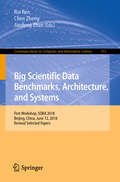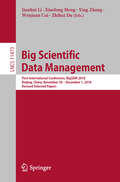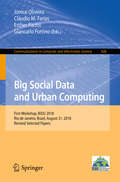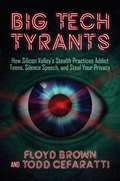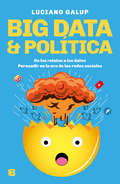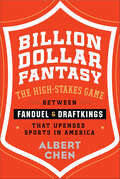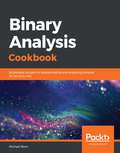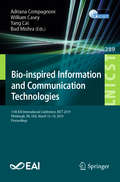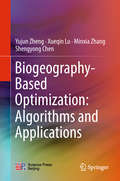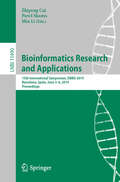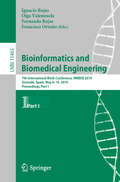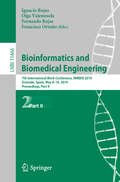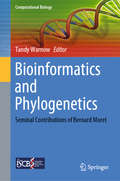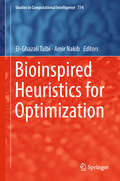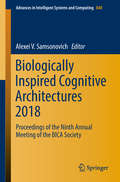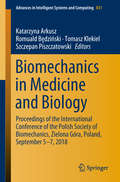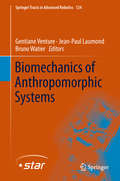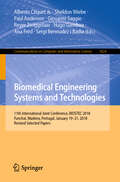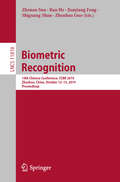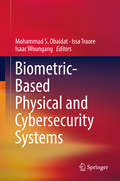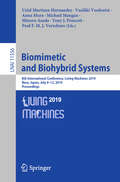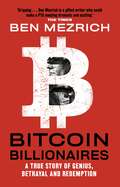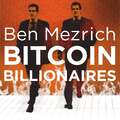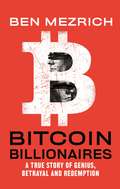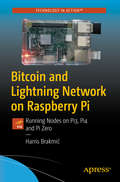- Table View
- List View
Big Scientific Data Benchmarks, Architecture, and Systems: First Workshop, SDBA 2018, Beijing, China, June 12, 2018, Revised Selected Papers (Communications in Computer and Information Science #911)
by Jianfeng Zhan Rui Ren Chen ZhengThis book constitutes the refereed proceedings of the First Workshop on Big Scientific Data Benchmarks, Architecture, and Systems, SDBA 2018, held in Beijing, China, in June 2018. The 10 revised full papers presented were carefully reviewed and selected from 22 submissions. The papers are organized in topical sections on benchmarking; performance optimization; algorithms; big science data framework.
Big Scientific Data Management: First International Conference, BigSDM 2018, Beijing, China, November 30 – December 1, 2018, Revised Selected Papers (Lecture Notes in Computer Science #11473)
by Ying Zhang Xiaofeng Meng Jianhui Li Wenjuan Cui Zhihui DuThis book constitutes the refereed proceedings of the First International Conference on Big Scientific Data Management, BigSDM 2018, held in Beijing, Greece, in November/December 2018. The 24 full papers presented together with 7 short papers were carefully reviewed and selected from 86 submissions. The topics involved application cases in the big scientific data management, paradigms for enhancing scientific discovery through big data, data management challenges posed by big scientific data, machine learning methods to facilitate scientific discovery, science platforms and storage systems for large scale scientific applications, data cleansing and quality assurance of science data, and data policies.
Big Social Data and Urban Computing: First Workshop, Bidu 2018, Rio De Janeiro, Brazil, August 31, 2018, Revised Selected Papers (Communications in Computer and Information Science #926)
by Giancarlo Fortino Esther Pacitti Jonice Oliveira Claudio M. FariasThis book constitutes the thoroughly refereed proceedings of the First Big Social Data and Urban Computing Workshop, BiDU 2018, held in Rio de Janeiro, Brazil, in August 2018. The 11 full papers presented were carefully reviewed and selected from 40 submissions. The papers are organized in topical sections on urban mobility, urban sensing, contemporary social problems, collaboration and crowdsourcing.
Big Tech Tyrants: How Silicon Valley's Stealth Practices Addict Teens, Silence Speech, and Steal Your Privacy
by Floyd Brown Todd CefarattiThey are driven without respect for the lives they are changing…“Boy Kings,” or Big Tech Tyrants, are considered the most powerful individuals in the world. They’re the autocratic aristocrats who run the tech giants in Silicon Valley, and if the labels are accurate, they suggest these social platform operators have gained a non-elected (or, should we say, a self-elected) authoritarian power. They wield it with more effectiveness and precision than any sitting government or military strategist. Big Tech Tyrants boast riches beyond emperors of old but act like juveniles who don’t want to grow up. They are modern-day robber barons. Big Tech Tyrants don’t know the meaning of privacy, when it comes to you. They try to make you believe they will give their products away for free as a service to society, when really, they are vacuuming your personal data. They use this data to discover your deepest secrets. Are you or your partner trying to get pregnant? Are you underwater financially? Are you having an extramarital affair? Do you have a tidy nest egg? Are you a Trump supporter? Are you a Bernie Sanders follower? Are you a Scientologist, Mormon, Christian, or Buddhist? Your personal data is extremely valuable to them—and they use it—and abuse. These tyrants knowingly addict users to make more money. Not only that, they also consider themselves the most enlightened the world has ever seen—so they know what’s best for you to see—from the news and information you read to the political candidates they think you should vote for. They censor news and only let you see what they want you to see. This is an eye-opening must read for anyone living in the twenty-first century!
Big data & Política: De los relatos a los datos. Persuadir en la era de las redes sociales
by Luciano GalupEl primer libro de uno de los analistas de marketing y consultoría con mayor proyección de los últimos años; un análisis pormenorizado de cómo la información se ha convertido en uno de los bienes más valiosos y las redes sociales en el medio esencial para la comunicación política en lo que va del siglo XXI. Vivimos en la era de los datos. Casi toda la actividad humana deja una huella digital que es almacenable y analizable. Los datos y las redes sociales se han convertido en una herramienta clave para la comunicación de nuestras sociedades y también para la orientación del debate público. Una parte cada vez más importante de los recursos de campañas políticas y de gobierno se destinan a las estrategias de análisis de datos y de comunicación digital. También crece el interés de los ciudadanos por el uso de los datos y de las redes sociales como mecanismos de participación y de seducción de voluntades. Casos como el de Cambridge Analytica y Facebook o la popularización de términos como "postverdad" o "noticias falsas" (fake news) amplificaron la difusión y el interés en las estrategias de comunicación política orientadas a redes sociales y la manipulación de información de los usuarios. Luciano Galup, uno de los mayores expertos argentinos en comunicación digital, analiza las transformaciones que estos medios revolucionarios entrañan para la política y para nuestra vida diaria. Explora cómo nos estamos adaptando a un mundo que produce cantidades desproporcionadas de información a velocidades irrefrenables. Estudia cómo se construye un candidato electoral en base a los datos sobre los votantes, en un contexto de fragmentación y microculturas, en el que un político ya no sólo debe saber hablar sino aprender a escuchar; y, a su vez, cómo se garantiza una participación amplia, transparente y genuina de la ciudadanía en el debate público. Y se pregunta, sobre todo, cómo comunicarse más y mejor para devolverle prestigio y credibilidad a la política y a la información, de cara a un mundo nuevo lleno de incertidumbres y grandes posibilidades.
Billion Dollar Fantasy: The High-Stakes Game Between FanDuel and DraftKings that Upended Sports in America
by Albert ChenBillion Dollar Fantasy has descriptive copy which is not yet available from the Publisher.
Binary Analysis Cookbook: Actionable recipes for disassembling and analyzing binaries for security risks
by Michael BornExplore open-source Linux tools and advanced binary analysis techniques to analyze malware, identify vulnerabilities in code, and mitigate information security risks Key Features Adopt a methodological approach to binary ELF analysis on Linux Learn how to disassemble binaries and understand disassembled code Discover how and when to patch a malicious binary during analysis Book Description Binary analysis is the process of examining a binary program to determine information security actions. It is a complex, constantly evolving, and challenging topic that crosses over into several domains of information technology and security. This binary analysis book is designed to help you get started with the basics, before gradually advancing to challenging topics. Using a recipe-based approach, this book guides you through building a lab of virtual machines and installing tools to analyze binaries effectively. You'll begin by learning about the IA32 and ELF32 as well as IA64 and ELF64 specifications. The book will then guide you in developing a methodology and exploring a variety of tools for Linux binary analysis. As you advance, you'll learn how to analyze malicious 32-bit and 64-bit binaries and identify vulnerabilities. You'll even examine obfuscation and anti-analysis techniques, analyze polymorphed malicious binaries, and get a high-level overview of dynamic taint analysis and binary instrumentation concepts. By the end of the book, you'll have gained comprehensive insights into binary analysis concepts and have developed the foundational skills to confidently delve into the realm of binary analysis. What you will learn Traverse the IA32, IA64, and ELF specifications Explore Linux tools to disassemble ELF binaries Identify vulnerabilities in 32-bit and 64-bit binaries Discover actionable solutions to overcome the limitations in analyzing ELF binaries Interpret the output of Linux tools to identify security risks in binaries Understand how dynamic taint analysis works Who this book is for This book is for anyone looking to learn how to dissect ELF binaries using open-source tools available in Linux. If you're a Linux system administrator or information security professional, you'll find this guide useful. Basic knowledge of Linux, familiarity with virtualization technologies and the working of network sockets, and experience in basic Python or Bash scripting will assist you with understanding the concepts in this book
Bio-inspired Information and Communication Technologies: 11th EAI International Conference, BICT 2019, Pittsburgh, PA, USA, March 13–14, 2019, Proceedings (Lecture Notes of the Institute for Computer Sciences, Social Informatics and Telecommunications Engineering #289)
by Yang Cai William Casey Adriana Compagnoni Bud MishraThis book constitutes the refereed conference proceedings of the 11th International Conference on Bio-Inspired Information and Communications Technologies, held in Pittsburgh, PA, USA, in March 2019. The 13 revised full papers and 2 short papers were selected from 29 submissions. Past iterations of the conference have attracted contributions in Direct Bioinspiration (physical biological materials and systems used within technology) as well as Indirect Bioinspiration (biological principles, processes and mechanisms used within the design and application of technology). This year, the scope has expanded to include a third thrust: Foundational Bioinspiration (bioinspired aspects of game theory, evolution, information theory, and philosophy of science).
Biogeography-Based Optimization: Algorithms and Applications
by Yujun Zheng Xueqin Lu Minxia Zhang Shengyong ChenThis book introduces readers to the background, general framework, main operators, and other basic characteristics of biogeography-based optimization (BBO), which is an emerging branch of bio-inspired computation. In particular, the book presents the authors’ recent work on improved variants of BBO, hybridization of BBO with other algorithms, and the application of BBO to a variety of domains including transportation, image processing, and neural network learning. The content will help to advance research into and application of not only BBO but also the whole field of bio-inspired computation. The algorithms and applications are organized in a step-by-step manner and clearly described with the help of pseudo-codes and flowcharts. The readers will learn not only the basic concepts of BBO but also how to apply and adapt the algorithms to the engineering optimization problems they actually encounter.
Bioinformatics Research and Applications: 15th International Symposium, ISBRA 2019, Barcelona, Spain, June 3–6, 2019, Proceedings (Lecture Notes in Computer Science #11490)
by Min Li Pavel Skums Zhipeng CaiThis book constitutes the proceedings of the 15th International Symposium on Bioinformatics Research and Applications, ISBRA 2019, held in Barcelona, Spain, in June 2019. The 22 full papers presented in this book were carefully reviewed and selected from 95 submissions. They were organized in topical sections named: genome analysis; systems biology; computational proteomics; machine and deep learning; and data analysis and methodology.
Bioinformatics and Biomedical Engineering: 7th International Work-Conference, IWBBIO 2019, Granada, Spain, May 8-10, 2019, Proceedings, Part I (Lecture Notes in Computer Science #11465)
by Ignacio Rojas Francisco Ortuño Olga Valenzuela Fernando RojasThe two-volume set LNBI 11465 and LNBI 11466 constitutes the proceedings of the 7th International Work-Conference on Bioinformatics and Biomedical Engineering, IWBBIO 2019, held in Granada, Spain, in May 2019. The total of 97 papers presented in the proceedings, was carefully reviewed and selected from 301 submissions. The papers are organized in topical sections as follows: Part I: High-throughput genomics: bioinformatics tools and medical applications; omics data acquisition, processing, and analysis; bioinformatics approaches for analyzing cancer sequencing data; next generation sequencing and sequence analysis; structural bioinformatics and function; telemedicine for smart homes and remote monitoring; clustering and analysis of biological sequences with optimization algorithms; and computational approaches for drug repurposing and personalized medicine. Part II: Bioinformatics for healthcare and diseases; computational genomics/proteomics; computational systems for modelling biological processes; biomedical engineering; biomedical image analysis; and biomedicine and e-health.
Bioinformatics and Biomedical Engineering: 7th International Work-Conference, IWBBIO 2019, Granada, Spain, May 8-10, 2019, Proceedings, Part II (Lecture Notes in Computer Science #11466)
by Ignacio Rojas Francisco Ortuño Olga Valenzuela Fernando RojasThe two-volume set LNBI 11465 and LNBI 11466 constitutes the proceedings of the 7th International Work-Conference on Bioinformatics and Biomedical Engineering, IWBBIO 2019, held in Granada, Spain, in May 2019. The total of 97 papers presented in the proceedings, was carefully reviewed and selected from 301 submissions. The papers are organized in topical sections as follows: Part I: High-throughput genomics: bioinformatics tools and medical applications; omics data acquisition, processing, and analysis; bioinformatics approaches for analyzing cancer sequencing data; next generation sequencing and sequence analysis; structural bioinformatics and function; telemedicine for smart homes and remote monitoring; clustering and analysis of biological sequences with optimization algorithms; and computational approaches for drug repurposing and personalized medicine. Part II: Bioinformatics for healthcare and diseases; computational genomics/proteomics; computational systems for modelling biological processes; biomedical engineering; biomedical image analysis; and biomedicine and e-health.
Bioinformatics and Phylogenetics: Seminal Contributions of Bernard Moret (Computational Biology #29)
by Tandy WarnowThis volume presents a compelling collection of state-of-the-art work in algorithmic computational biology, honoring the legacy of Professor Bernard M.E. Moret in this field. Reflecting the wide-ranging influences of Prof. Moret’s research, the coverage encompasses such areas as phylogenetic tree and network estimation, genome rearrangements, cancer phylogeny, species trees, divide-and-conquer strategies, and integer linear programming. Each self-contained chapter provides an introduction to a cutting-edge problem of particular computational and mathematical interest.Topics and features: addresses the challenges in developing accurate and efficient software for the NP-hard maximum likelihood phylogeny estimation problem; describes the inference of species trees, covering strategies to scale phylogeny estimation methods to large datasets, and the construction of taxonomic supertrees; discusses the inference of ultrametric distances from additive distance matrices, and the inference of ancestral genomes under genome rearrangement events; reviews different techniques for inferring evolutionary histories in cancer, from the use of chromosomal rearrangements to tumor phylogenetics approaches; examines problems in phylogenetic networks, including questions relating to discrete mathematics, and issues of statistical estimation; highlights how evolution can provide a framework within which to understand comparative and functional genomics; provides an introduction to Integer Linear Programming and its use in computational biology, including its use for solving the Traveling Salesman Problem.Offering an invaluable source of insights for computer scientists, applied mathematicians, and statisticians, this illuminating volume will also prove useful for graduate courses on computational biology and bioinformatics.
Bioinspired Heuristics for Optimization (Studies in Computational Intelligence #774)
by El-Ghazali Talbi Amir NakibThis book presents recent research on bioinspired heuristics for optimization. Learning- based and black-box optimization exhibit some properties of intrinsic parallelization, and can be used for various optimizations problems. Featuring the most relevant work presented at the 6th International Conference on Metaheuristics and Nature Inspired Computing, held at Marrakech (Morocco) from 27th to 31st October 2016, the book presents solutions, methods, algorithms, case studies, and software. It is a valuable resource for research academics and industrial practitioners.
Biologically Inspired Cognitive Architectures 2018: Proceedings Of The Ninth Annual Meeting Of The Bica Society (Advances In Intelligent Systems and Computing #848)
by Alexei V. SamsonovichThe book focuses on original approaches intended to support the development of biologically inspired cognitive architectures. It bridges together different disciplines, from classical artificial intelligence to linguistics, from neuro- and social sciences to design and creativity, among others. The chapters, based on contributions presented at the Ninth Annual Meeting of the BICA Society, held in on August 23-24, 2018, in Prague, Czech Republic, discuss emerging methods, theories and ideas towards the realization of general-purpose humanlike artificial intelligence or fostering a better understanding of the ways the human mind works. All in all, the book provides engineers, mathematicians, psychologists, computer scientists and other experts with a timely snapshot of recent research and a source of inspiration for future developments in the broadly intended areas of artificial intelligence and biological inspiration.
Biomechanics in Medicine and Biology: Proceedings of the International Conference of the Polish Society of Biomechanics, Zielona Góra, Poland, September 5-7, 2018 (Advances in Intelligent Systems and Computing #831)
by Katarzyna Arkusz Romuald Będziński Tomasz Klekiel Szczepan PiszczatowskiThis book presents the proceedings of the “International Conference of the Polish Society of Biomechanics – BIOMECHANICS 2018” held in Zielona Góra, Poland from September 5 to 7, 2018, and discusses recent research on innovations in biomechanics.It includes a collection of selected papers in all key areas of biomechanics, including cellular, molecular, neuro and musculoskeletal biomechanics, as well as sport, clinical and rehabilitation biomechanics. These themes are extremely important in the development of engineering concepts and methods to provide new medical solutions, especially in the context of an ageing population.Presenting the latest technical advances and research methods used in clinical biomechanics, this book is of interest to scientists as well as junior researchers and students of interdisciplinary fields of engineering, medical, and sports sciences.
Biomechanics of Anthropomorphic Systems (Springer Tracts in Advanced Robotics #124)
by Jean-Paul Laumond Gentiane Venture Bruno WatierMechanical laws of motion were applied very early for better understanding anthropomorphic action as suggested in advance by Newton «For from hence are easily deduced the forces of machines, which are compounded of wheels, pullies, levers, cords, and weights, ascending directly or obliquely, and other mechanical powers; as also the force of the tendons to move the bones of animals». In the 19th century E.J. Marey and E. Muybridge introduced chronophotography to scientifically investigate animal and human movements. They opened the field of motion analysis by being the first scientists to correlate ground reaction forces with kinetics.Despite of the apparent simplicity of a given skilled movement, the organization of the underlying neuro-musculo-skeletal system remains unknown. A reason is the redundancy of the motor system: a given action can be realized by different muscle and joint activity patterns, and the same underlying activity may give rise to several movements. After the pioneering work of N. Bernstein in the 60’s on the existence of motor synergies, numerous researchers «walking on the border» of their disciplines tend to discover laws and principles underlying the human motions and how the brain reduces the redundancy of the system. These synergies represent the fundamental building blocks composing complex movements.In robotics, researchers face the same redundancy and complexity challenges as the researchers in life sciences. This book gathers works of roboticists and researchers in biomechanics in order to promote an interdisciplinary research on anthropomorphic systems at large and on humanoid robotics in particular.
Biomedical Engineering Systems and Technologies: 11th International Joint Conference, BIOSTEC 2018, Funchal, Madeira, Portugal, January 19–21, 2018, Revised Selected Papers (Communications in Computer and Information Science #1024)
by Paul Anderson Reyer Zwiggelaar Ana Fred Hugo Gamboa Giovanni Saggio Alberto Cliquet Jr. Sheldon Wiebe Sergi Bermúdez i BadiaThis book constitutes the thoroughly refereed post-conference proceedings of the 11th International Joint Conference on Biomedical Engineering Systems and Technologies, BIOSTEC 2018, held in Funchal, Madeira, Portugal, in January 2018.The 25 revised full papers presented were carefully reviewed and selected from a total of 299 submissions. The papers are organized in topical sections on biomedical electronics and devices; bioimaging; bioinformatics models, methods and algorithms; health informatics.
Biometric Recognition: 14th Chinese Conference, CCBR 2019, Zhuzhou, China, October 12–13, 2019, Proceedings (Lecture Notes in Computer Science #11818)
by Ran He Zhenhua Guo Shiguang Shan Zhenan Sun Jianjiang FengThe LNCS volume 11818 constitutes the proceedings of the 14th Chinese Conference on Biometric Recognition, held in Zhuzhou, China, in October 2019. The 56 papers presented in this book were carefully reviewed and selected from 74 submissions. The papers cover a wide range of topics such as face recognition and analysis; hand-based biometrics; eye-based biometrics; gesture, gait, and action; emerging biometrics; feature extraction and classification theory; and behavioral biometrics.
Biometric-Based Physical and Cybersecurity Systems
by Isaac Woungang Mohammad S. Obaidat Issa TraoreThis book presents the latest developments in biometrics technologies and reports on new approaches, methods, findings, and technologies developed or being developed by the research community and the industry. The book focuses on introducing fundamental principles and concepts of key enabling technologies for biometric systems applied for both physical and cyber security. The authors disseminate recent research and developing efforts in this area, investigate related trends and challenges, and present case studies and examples such as fingerprint, face, iris, retina, keystroke dynamics, and voice applications . The authors also investigate the advances and future outcomes in research and development in biometric security systems. The book is applicable to students, instructors, researchers, industry practitioners, and related government agencies staff. Each chapter is accompanied by a set of PowerPoint slides for use by instructors.
Biomimetic and Biohybrid Systems: 8th International Conference, Living Machines 2019, Nara, Japan, July 9–12, 2019, Proceedings (Lecture Notes in Computer Science #11556)
by Tony J. Prescott Michael Mangan Minoru Asada Anna Mura Vasiliki Vouloutsi Uriel Martinez-Hernandez Paul F. M. J. VerschureThis book constitutes the proceedings of the 8th International Conference on Biomimetic and Biohybrid Systems, Living Machines 2019, held in Nara, Japan, in July 2019. The 26 full and 16 short papers presented in this volume were carefully reviewed and selected from 45 submissions. They deal with research on novel life-like technologies inspired by the scientific investigation of biological systems, biomimetics, and research that seeks to interface biological and artificial systems to create biohybrid systems.
Bitcoin Billionaires: A True Story of Genius, Betrayal and Redemption
by Ben MezrichFrom Ben Mezrich, the New York Times bestselling author of The Accidental Billionaires and Bringing Down the House, comes Bitcoin Billionaires - the fascinating story of brothers Tyler and Cameron Winklevoss's big bet on crypto-currency and its dazzling pay-off.Ben Mezrich's 2009 bestseller The Accidental Billionaires is the definitive account of Facebook's founding - and the basis for the Academy Award-winning film The Social Network. Two of the story's iconic characters are Harvard students Tyler and Cameron Winklevoss: identical twins, Olympic rowers, and legal foils to Mark Zuckerberg. Bitcoin Billionaires is the story of the brothers' redemption and revenge in the wake of their epic legal battle with Facebook - and the first great book from the world of bitcoin.Planning to start careers as venture capitalists, the brothers quickly discover that no one will take their money for fear of alienating Zuckerberg. While nursing their wounds in Ibiza, they accidentally run into a shady character who tells them about a brand new idea: cryptocurrency. Immersing themselves in what is then an obscure and sometimes sinister world, they begin to realize "crypto" is, in their own words, "either the next big thing or total bulls--t." There's nothing left to do but make a bet.From the Silk Road to the halls of the Securities and Exchange Commission to the Facebook boardroom, Bitcoin Billionaires will take us on a wild and surprising ride while illuminating a tantalizing economic future. On November 26th, 2017, the Winklevoss brothers became the first bitcoin billionaires. Here's the story of how they got there - as only Ben Mezrich could tell it.
Bitcoin Billionaires: A True Story of Genius, Betrayal and Redemption
by Ben MezrichFrom Ben Mezrich, the New York Times bestselling author of The Accidental Billionaires and Bringing Down the House, comes Bitcoin Billionaires - the fascinating story of brothers Tyler and Cameron Winklevoss's big bet on crypto-currency and its dazzling pay-off.Ben Mezrich's 2009 bestseller The Accidental Billionaires is the definitive account of Facebook's founding - and the basis for the Academy Award-winning film The Social Network. Two of the story's iconic characters are Harvard students Tyler and Cameron Winklevoss: identical twins, Olympic rowers, and legal foils to Mark Zuckerberg. Bitcoin Billionaires is the story of the brothers' redemption and revenge in the wake of their epic legal battle with Facebook - and the first great book from the world of bitcoin.Planning to start careers as venture capitalists, the brothers quickly discover that no one will take their money for fear of alienating Zuckerberg. While nursing their wounds in Ibiza, they accidentally run into a shady character who tells them about a brand new idea: cryptocurrency. Immersing themselves in what is then an obscure and sometimes sinister world, they begin to realize "crypto" is, in their own words, "either the next big thing or total bulls--t." There's nothing left to do but make a bet.From the Silk Road to the halls of the Securities and Exchange Commission to the Facebook boardroom, Bitcoin Billionaires will take us on a wild and surprising ride while illuminating a tantalizing economic future. On November 26th, 2017, the Winklevoss brothers became the first bitcoin billionaires. Here's the story of how they got there - as only Ben Mezrich could tell it.
Bitcoin Billionaires: A True Story of Genius, Betrayal, and Redemption
by Ben MezrichFrom Ben Mezrich, the New York Times bestselling author of The Accidental Billionaires and Bringing Down the House, comes Bitcoin Billionaires--the fascinating story of brothers Tyler and Cameron Winklevoss's big bet on crypto-currency and its dazzling pay-off. Ben Mezrich's 2009 bestseller The Accidental Billionaires is the definitive account of Facebook's founding and the basis for the Academy Award–winning film The Social Network. Two of the story's iconic characters are Harvard students Tyler and Cameron Winklevoss: identical twins, Olympic rowers, and foils to Mark Zuckerberg. Bitcoin Billionaires is the story of the brothers’ redemption and revenge in the wake of their epic legal battle with Facebook. Planning to start careers as venture capitalists, the brothers quickly discover that no one will take their money after their fight with Zuckerberg. While nursing their wounds in Ibiza, they accidentally run into an eccentric character who tells them about a brand-new idea: cryptocurrency. Immersing themselves in what is then an obscure and sometimes sinister world, they begin to realize “crypto” is, in their own words, "either the next big thing or total bulls--t." There’s nothing left to do but make a bet. From the Silk Road to the halls of the Securities and Exchange Commission, Bitcoin Billionaires will take us on a wild and surprising ride while illuminating a tantalizing economic future. On November 26, 2017, the Winklevoss brothers became the first bitcoin billionaires. Here’s the story of how they got there—as only Ben Mezrich could tell it.
Bitcoin and Lightning Network on Raspberry Pi: Running Nodes on Pi3, Pi4 and Pi Zero
by Harris BrakmićCompile and run Bitcoin full nodes, lightning nodes, and user-friendly web-apps that help abstract the complexities of Bitcoin. This book not only explains the tools and techniques to help readers build their own banks and banking apps, but it also tells a story. Starting with the origins of Bitcoin—what it is and why we need it—find out what its strengths and limitations are. Understand the nature of mining and why so much energy is put into it. The blockchain itself will be reviewed, as well, and compared to other options such as a normal SQL database or a simple spreadsheet.With this book, you can control Bitcoin wallets via RPC commands on a Raspberry Pi. Configure, compile, and run two implementation of the Lightning Network-compatible daemons: LND and c-lightning. And employ user-friendly web apps that abstract the complexities of Bitcoin/Lightning-Network.The Internet of Information is currently transitioning to the Internet of Things, which in turn may well be followed by the Internet of Value (or Money). However, there is no evolution without happy users and Bitcoin will never reach the same heights like the original internet without having offered “useful” and “easy to use” tools. Just like nobody would ever want to use UUCP to send messages via web the same applies to current cryptocurrency tools. These are hard to use and very unforgiving. But, the evolution doesn’t stop here and many easy-to-use tools are already available. We will meet some of them when building apps for the Lightning Network, a new technology running on top of Bitcoin’s blockchain that makes it possible to generate billions of transactions within a single second. What You'll LearnControl Bitcoin wallets via console RPC commandsRun two implementation of the Lightning Network compatible daemonsSimplify the complexities of Bitcoin and the Lightning network with user-friendly web appsWho This Book Is ForThis book is for Makers familiar with the basics of Linux command line processes.
